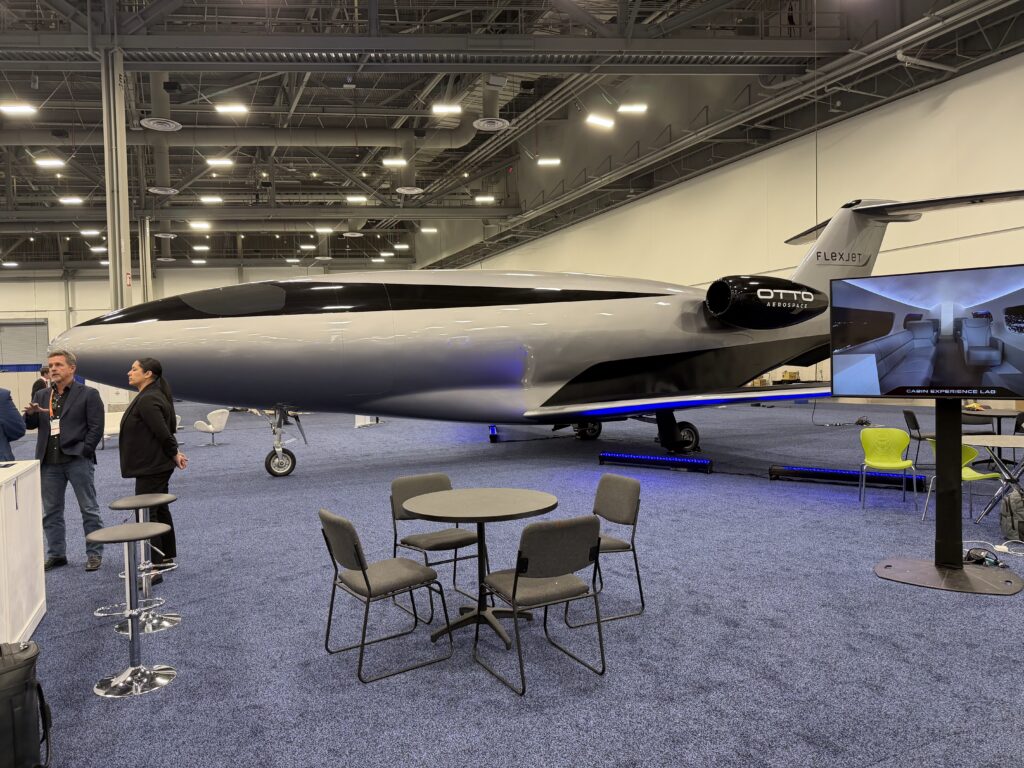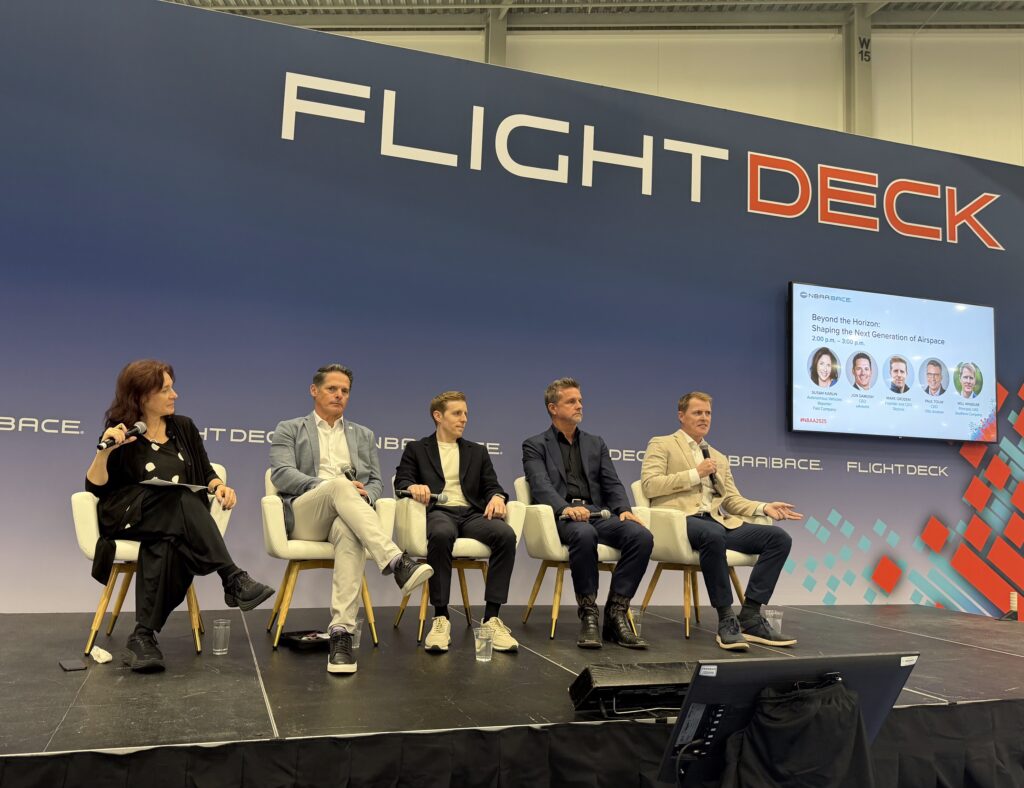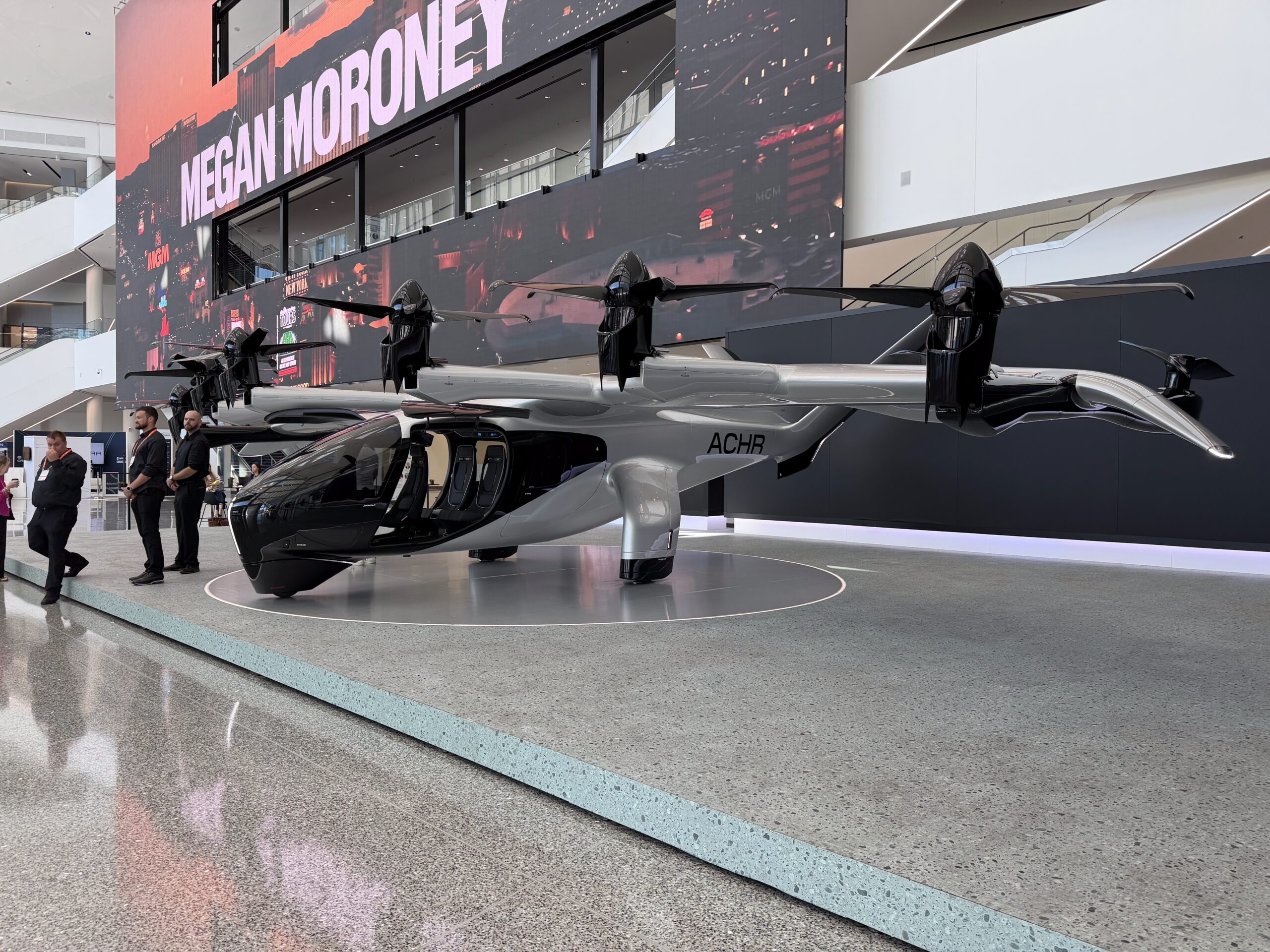By: Charlton Evans, AG Certification Ambassador
At this year’s NBAA-BACE in Las Vegas, a packed room looked skyward (if not literally, then figuratively) during the “Beyond the Horizon” panel. Moderated by Fast Company’s Susan Karlin, the conversation between uAvionix CEO Jon Damush, Skyryse founder Mark Groden, Otto Aviation CEO Paul Touw (represented by COO Scott Drennan), and Southern Company’s UAS Principal Will Wheeler painted a grounded picture of how the next decade of flight might unfold. The takeaway was clear: the skies of the future will be smarter, safer, more connected, yet still, reassuringly human.
During much of the conversation, one theme rose above the hum of innovation: automation will augment, not replace, the human operator. “We’re not taking the pilot out of the loop,” Groden said. “We’re giving them more control with higher levels of automation and safety.” His analogy was simple: even the most automated systems, like elevators, still rely on human intent. In Skyryse’s world, the flight deck becomes an intuitive interface, what Groden called “simplified vehicle operations,” which enables pilots to manage aircraft more safely and efficiently.
Damush echoed this sentiment. “We live in the slowest time we will ever live,” he said, referencing futurist Ray Kurzweil. “The pace of change is accelerating, but the regulations will take longer to catch up.” His point: while technology can safely operate autonomously, the path to public trust and FAA certification remains measured and deliberate.
Elegant engineering, not just flashy tech, will move aviation forward. Otto Aviation’s Drennan brought a systems view to the discussion by emphasizing aircraft design that balances sophistication and simplicity. “We call it essential complexity,” he explained. “Enough to create function and safety, not so much that it overwhelms the human interface.” Otto’s Celera 500L, a sleek, efficient aircraft built for sustainable business travel, is designed around that philosophy. It burns 60 percent less fuel and cuts emissions by up to 90 percent. Elegant engineering, not just flashy tech, will move aviation forward.

That logic applies not just to pilots, but maintainers and fleet operators, where predictive maintenance, health monitoring and digital diagnostics will define the next generation of aviation uptime. Otto’s aircraft uses new and novel manufacturing techniques to create an extremely low drag solution.
Autonomous Drones Pave the Way For Utilities…and Business Aviation
Drone operations are proving grounds for the scaled airspace of 2035. Thousands of autonomous flights a day, many in low-altitude environments, continue to quietly validate technologies that will later migrate into passenger aviation. As Damush put it, unmanned flights “change the calculus of risk” by allowing innovation in scenarios where human safety isn’t directly at stake.
Case in point: while manufacturers grapple with the certification maze, the utility sector, ironically one of the most risk-averse industries, is already living in aviation’s automated future. “We fly 18,000 miles of transmission line beyond visual line of sight (BVLOS),” Wheeler explained of Southern Company’s drone operations. The utility conducts post-storm assessments and inspections autonomously through its aerial operations center near Atlanta. “Regulators respond to safety evidence, and automation gives us exactly that.”
Even as automation gains traction, certification remains a chokepoint. “There’s a lack of transparency and clarity in the process,” Groden said candidly. For startups, that opacity burns through capital and time. “Investors want to know how certification works, but when they hear about “issue papers” it sounds like the FAA has a problem with your technology. It’s not true, but perception matters.” [Issue Papers are how the FAA deals with new and novel technologies that rules don’t directly address.]
Damush offered a glimmer of optimism. “We used to have to wait for failure to drive change,” he said. “Now the regulator sees the safety and economic benefits of new technology.” He cited uAvionix’s work helping the FAA modernize air traffic control at smaller airports. Through the Surface Awareness Initiative, the agency is deploying ground-based ADS-B receivers to replace outdated tower procedures still reliant on binoculars. “I’ve never seen the FAA move this fast,” Damush said.

Still, the ecosystem has friction. “We have unmatched engineering talent and market demand,” he noted. “But we need to reduce the friction between them, cut the time and uncertainty between investment and revenue.”
Groden argued that transparency isn’t just a regulatory issue; it’s an economic one. “Investors treat certification like a black box,” he said. “If we demystify that, capital will flow, and you’ll see a very different industry.”
Manufacturing at Home and Sustaining the Lead
Drennan sees U.S. manufacturing as a linchpin of aviation leadership. “We’re bringing as much production back to the States as possible,” he said. “Manufacturing is a skillset we can’t afford to lose.” For Otto, that also means sustainability parity with affordability. “In our aircraft, you can burn Jet A or sustainable aviation fuel and still pay less than competitors flying only Jet A,” he noted. “It’s the first time in green markets there’s a green discount instead of a premium.”
Damush pointed to vulnerabilities in supply chains, especially at the silicon level. “We need to make more chips here,” he warned. “Right now, we’re 100 percent beholden to Taiwan.” The CHIPS Act is a start, he said, but time, incentives and policy alignment will decide whether aerospace regains its domestic hardware edge.
For all the talk of automation, one technological goal stood out as urgent: universal visibility. “Every [commercial] aircraft should electronically share its position,” Damush said. Full situational awareness, through systems like ADS-B and other emerging systems, can take pressure off air traffic controllers and allow systems and pilots alike to avoid collisions independently. In a near-future sky with hundreds of thousands of drones, air taxis and private aircraft sharing low altitudes, electronic conspicuity will be the cornerstone of safety.
Despite all the systems talk, everyone onstage returned to a surprisingly human truth: the operator, the pilot, technician, or dispatcher are still the backbone of aviation safety as well as its greatest vulnerability. “Eighty percent of fatal general aviation accidents are due to pilot error,” Damush said. “Mostly controlled flight into terrain or loss of control, both linked to workload.” Automation, in his view, isn’t about eliminating pilots but giving them “cognitive space” to make better decisions.
Groden framed it another way. “The phrase ‘pilot error’ suggests incompetence,” he said. “But pilots are operating at the limit of a machine’s design.” His goal is to redefine the cockpit, much as modern cars abstract away complex mechanics so that drivers simply drive. “Make the [helicopter] inherently stable,” he said. “Then the human can focus on navigating, communicating and managing risk.” Essentially managing the systems through a simple interface rather than managing the energy of the aircraft.
When asked which customers are leading the adoption of automation, Groden didn’t hesitate. “Emergency services and firefighting,” he said. “The technology literally helps them hit the target.” Skyryse recently signed a contract with CAL FIRE, bringing automation to aerial firefighting, where dropping water has long been as much art as science. “About 50 percent of water misses its target,” Groden revealed. “Automation can fix that.”
The same technologies will ripple through air medical evacuations, cargo flights and eventually point-to-point business aviation. “Every mission succeeds when safety and efficiency align,” he said. And both, the panel agreed, are increasingly data-driven.
Drennan captured what may be the industry’s quiet revolution: “We have so much data now, from design through retirement,” he said. “If you can turn that data into useful information, you can make better safety decisions and better business ones.” This idea resonated across the panel. Data, not hype, bridges innovation and trust. The FAA, after all, approves not concepts but compliance data.
The Shape of 2035
By the panel’s end, there was little talk of sci-fi skies filled with robotic air taxis. Instead, the shared vision was incremental yet inspiring. Dramatic progress in sustainability, manufacturing, system design and human-machine trust will make aviation more intuitive, accessible and widespread.
Wheeler summed it up best: “Automation isn’t about removing people. It’s about letting them do the right work.” For all their technical mastery, these architects of the next air age seem less obsessed with replacing pilots than enabling pilots, less intent on “revolution,” than refinement. The horizon they’re building toward isn’t beyond reach. It’s just higher, clearer and open to anyone ready to look up.

